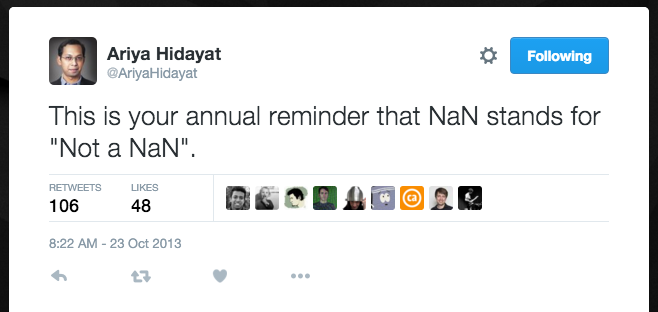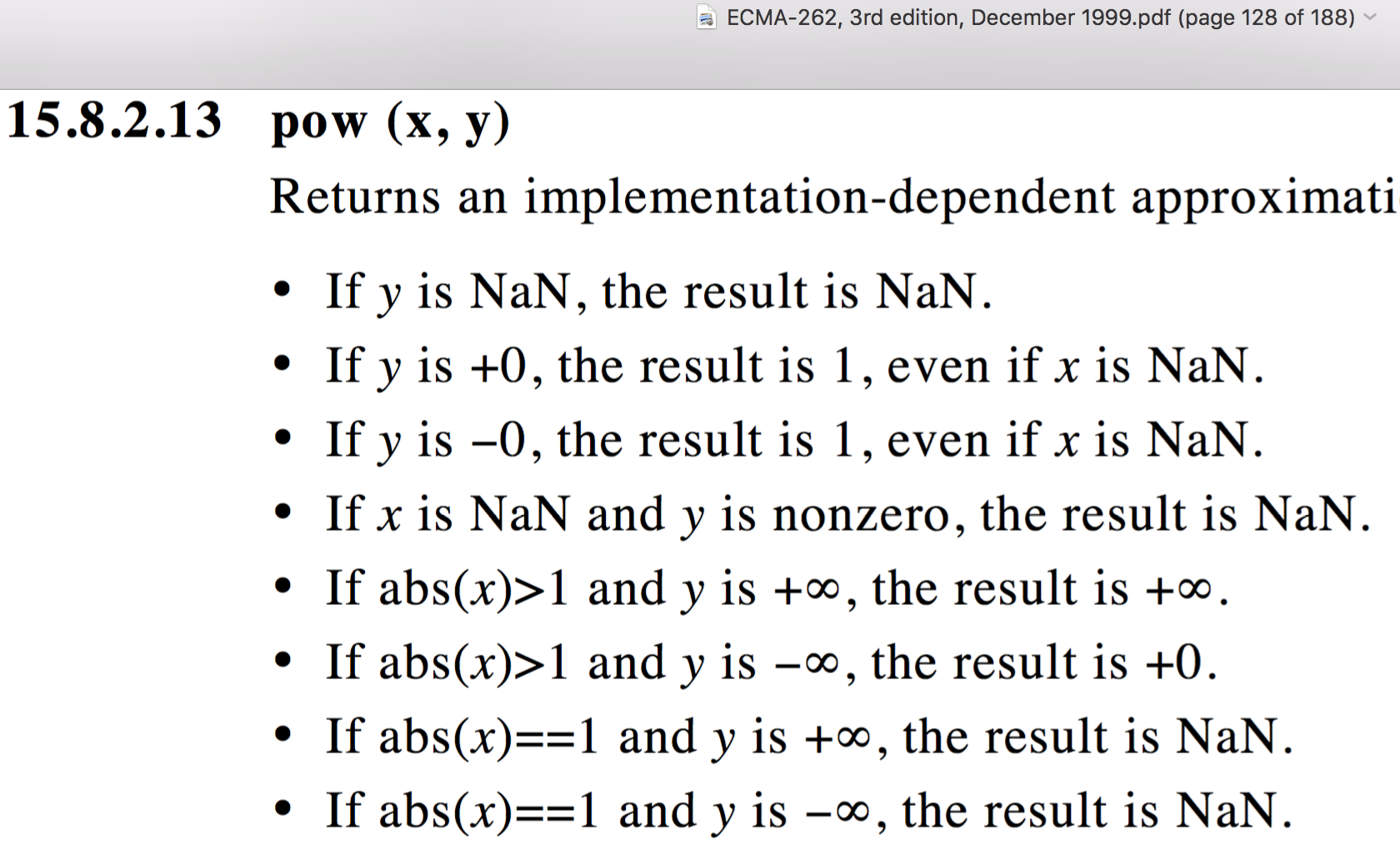这是一个大约需要花10-15分钟看完的技术讲义,关于 NaN 是什么?它会在哪里出现?以及对于它大家需要知道些什么?
讲义的作者是 Lewis J Ellis,有一份这个讲义的演讲视频录像,还可以在 Github 上找到这个讲义的项目。
“NaN” 的意思是:
Not a Number
什么东西会给我们一个NaN?
令人头晕的数学计算
1 | console.log( |
1 | > NaN NaN NaN NaN |
复杂的数字
1 | console.log( |
1 | > NaN NaN NaN NaN |
将其他类型转换为数字
1 | console.log( |
1 | > NaN NaN NaN NaN NaN NaN NaN |
在 JavaScript 中,NaN 是什么
“Not a Number” 是…
1 | console.log(NaN); |
1 | > NaN |
… 一个特殊的 JavaScript 值.
(非常 特殊)
“Not a Number” 是…
1 | console.log(typeof NaN); |
1 | > number |
…一个 Number.

“Not a Number” 是…
1 | console.log(NaN === NaN); |
1 | > false |
… 不是一个”Not a Number”.

“Not a Number” 是…
1 | var assert = require('assert'); |
1 | > AssertionError: NaN == NaN |
…棘手的测试.
“NaN” 实际上意思是:
Not a NaN

所以我们知道了 NaN 在什么地方出现, 但是我们如何判断一个值是 NaN ?
放轻松!只需要使用 isNaN 方法:
1 | console.log(isNaN(NaN)); |
1 | > true |
也许可能不是…
1 | console.log(isNaN('foo'), isNaN(['bar']), isNaN({})); |
1 | > true true true |
1 | console.log(typeof 'foo', typeof ['bar'], typeof {}); |
1 | > string object object |

我们自己写一个方法来判断:
1 | function myIsNaN(x) { |
1 | > true true true true |
或者我们可以回调 “Not a NaN”:
1 | function myIsNaN(x) { |
1 | > true true true true |
这个方法有用是因为 NaN 是 JavaScript 中唯一一个等号操作符是非自反的值。
幸运的是, ES2015 中增加了 Number.isNaN:
1 | console.log([NaN, 'foo', ['bar'], {}].map(isNaN)); |
…它正是我们想要的方法:1
2> true true true true
> true false false false
或者我们也可以 用 Object.is:
1 | console.log([NaN, 'foo', ['bar'], {}].map(isNaN)); |
1 | > true true true true |
这种方法用到了 SameValue 这个内部操作,它的对比方式与 Set 区分元素的方法(大部分)相似。
但是 NaN 不仅仅是 JavaScript 中才有的!
NaN 实际上是在 IEEE 754 浮点标准中定义的。
如果你知道 NaN 在一种语言中可能出现的地方,以及它的表现,那么它在其他语言中也大致相似。
IEEE 754 规范定义了 pow 方法:
1 | pow(2, 3) -> 8 |
If either input is NaN, or if the base is negative and the exponent is not an integer, the result is NaN.
如果输入是 NaN ,或者基数为负且指数不是整数,则结果为 NaN。
三种不明确的 pow:
1 | pow(0, 0) -> 1 |
这种行为 继承自 C99 和 POSIX 2001
多数语言都遵循这一条规则
这是 Python 的行为 :
1 | [0 ** 0, float("inf") ** 0, 1 ** float("inf")] |
1 | > [1 1.0 1.0] |
Ruby :
1 | [0 ** 0, Float::INFINITY ** 0, 1 ** Float::INFINITY] |
1 | > [1 1.0 1.0] |
Lua :
1 | print(math.pow(0, 0), math.pow(math.huge, 0), math.pow(1, math.huge)) |
1 | > 1 1 1 |
但是JavaScript?
1 | Math.pow(0, 0); |
1 | Math.pow(0, 0); |
1 | > 1 |
1 | Math.pow(0, 0); |
1 | > 1 |
1 | Math.pow(Infinity, 0); |
1 | Math.pow(0, 0); |
1 | > 1 |
1 | Math.pow(Infinity, 0); |
1 | > 1 |
1 | Math.pow(0, 0); |
1 | > 1 |
1 | Math.pow(Infinity, 0); |
1 | > 1 |
1 | Math.pow(1, Infinity); |
1 | Math.pow(0, 0); |
1 | > 1 |
1 | Math.pow(Infinity, 0); |
1 | > 1 |
1 | Math.pow(1, Infinity); |
1 | > NaN |

为什么?


- ES
1声明pow: 1997 - C99 声明
pow: 1999 - POSIX 声明
pow: 2001 - IEEE 754 声明
pow: 2008

就像关于 JavaScript 的其他问题一样,答案就是…
向后兼容
所以不论如何,看看 IEEE 754 告诉我们要如何表示 NaN?
float32 类型值的 bit 表达方式:
1 | 0 10000000 01000000000000000000000 |
- 1 位符号
- 8 位指数, 偏移量
127 - 23 位有效位数 (前面的第24位隐藏)
(-1) ^ s * 2 ^ (exp - 127) * 1.significand
例如 float32 的值:
1 | 0 10000000 01000000000000000000000 |
(-1) ^ 0 = 12 ^ (10000000b - 127) = 21.01b = 1.251 * 2 * 1.25 = 2.5
特殊值的 bit 表达方式:
1 | 0 11111111 00000000000000000000000 -> Infinity |
Infinity 的值有一个最大的指数和一个为零的有效位数。
特殊值的 bit 表达方式:
1 | 0 11111111 10000000000000000000000 -> NaN |
NaN 的值有一个最大的指数和一个非零的有效位数。
这些也都是 NaN:
1 | 1 11111111 10000000000000000000000 -> NaN (quiet, negative) |
这些也都是 NaN:
1 | 1 11111111 10000000000000000000000 -> NaN (quiet, negative) |
一共有多少个NaN,真的吗?
2^24 - 2 = 16,777,214
这只是类型位 float32 的情况下!
那么如果是 double64 呢?
2^53 - 2 = 9,007,199,254,740,990
也就是 9 * 10^15, 或者 9 万亿.
9PB相当于可以播放20000年的音乐
如果有这么多可能的 NaN ,那这一切才看起来合理了些…
…就是说一个随机的 NaN 几乎不可能等于另一个随机的 NaN!
因此, NaN !== NaN[^1].
[^1]: With probability 1/9,007,199,254,740,990.